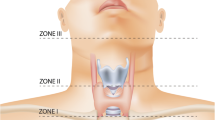Abstract
The purpose of this study was to evaluate the ability of helical computed tomographic angiography (HCTA) to detect vascular injury in penetrating neck trauma. Thirty-five patients (30 gunshot wounds and 5 stab wounds) were studied prospectively with HCTA. Scans were performed with a 5-mm slice thickness at a 1:1 pitch after injection of 90 ml of nonionic contrast medium (30-second delay) at 3 ml/sec. Results were compared with those for angiography (29), surgery (3), ultrasound (2), and local inspection (1). HCTA correctly revealed 19 normal and 10 abnormal studies. In 8 cases, HCTA revealed irregular vessel margins (3), contrast extravasation (2), lack of vascular enhancement (1), and caliber changes (2). In 2 patients, HCTA revealed indirect signs of injury only. In 6 cases, HCTA findings did not correlate with angiography. HCTA detects both direct and indirect signs of vascular injury. Although indirect findings are more sensitive, the direct evaluation of vessels increases the specificity and has a high negative predictive value.
Similar content being viewed by others
References
Rubin GD, Dake MD, Semba CP. Current status of three-dimensional spiral CT scanning for imaging the vasculature. Radiol Clin North Am 1995;33:51–70.
Napel S, Marks MP, Rubin GD, Dake MD, McDonnell CH, Song SM, et al. CT angiography with spiral CT and maximum intensity projection. Radiology 1992;185:607–10.
Schwartz RB, Jones KM, Chernoff DM, Mukherji SK, Khorasani R, Tice HM, et al. Common carotid artery bifurcation: evaluation with spiral CT. Radiology 1992;185:513–9.
Dillon EH, van Leeuwen MS, Fernandez MA, Eikelboom BC, Mali WP. CT angiography: application to the evaluation of carotid artery stenosis. Radiology 1993;189:211–9.
Marks MP, Nape S, Jordan JE, Enzmann DR. Diagnosis of carotid artery disease: preliminary experience with maximum-intensity-projection spiral CT angiography. AJR Am J Roentgenol 1993;160:1267–71.
Castillo M. Diagnosis of disease of the common carotid artery bifurcation: CT angiography versus catheter angiography. AJR Am J Roentgenol 1993;161:395–8.
LeBlang SD, Nuñez DB, Serafini A, Duncan RC, Donovan Post MJ, Montalvo BM, Becerra JL. Computed tomography in gunshot wounds to the neck: can we predict vascular injury? Emerg Radiol 1997;4:191–9.
Nuñez DB, Ahmad AA, Coin CG, LeBlang SD, Becerra JL, Henry R, et al. Clearing the cervical spine in multiple trauma victims: a time-effective protocol using helical computed tomography. Emerg Radiol 1994;1:273–8.
Frykberg ER, Vines FS, Alexander R. The natural history of clinically occult arterial injuries: a prospective evaluation. J Trauma 1989;29:577–83.
Author information
Authors and Affiliations
Rights and permissions
About this article
Cite this article
LeBlang, S.D., Nuñez, D.B., Rivas, L.A. et al. Helical computed tomographic angiography in penetrating neck trauma. Emergency Radiology 4, 200–206 (1997). https://doi.org/10.1007/BF01508171
Issue Date:
DOI: https://doi.org/10.1007/BF01508171




